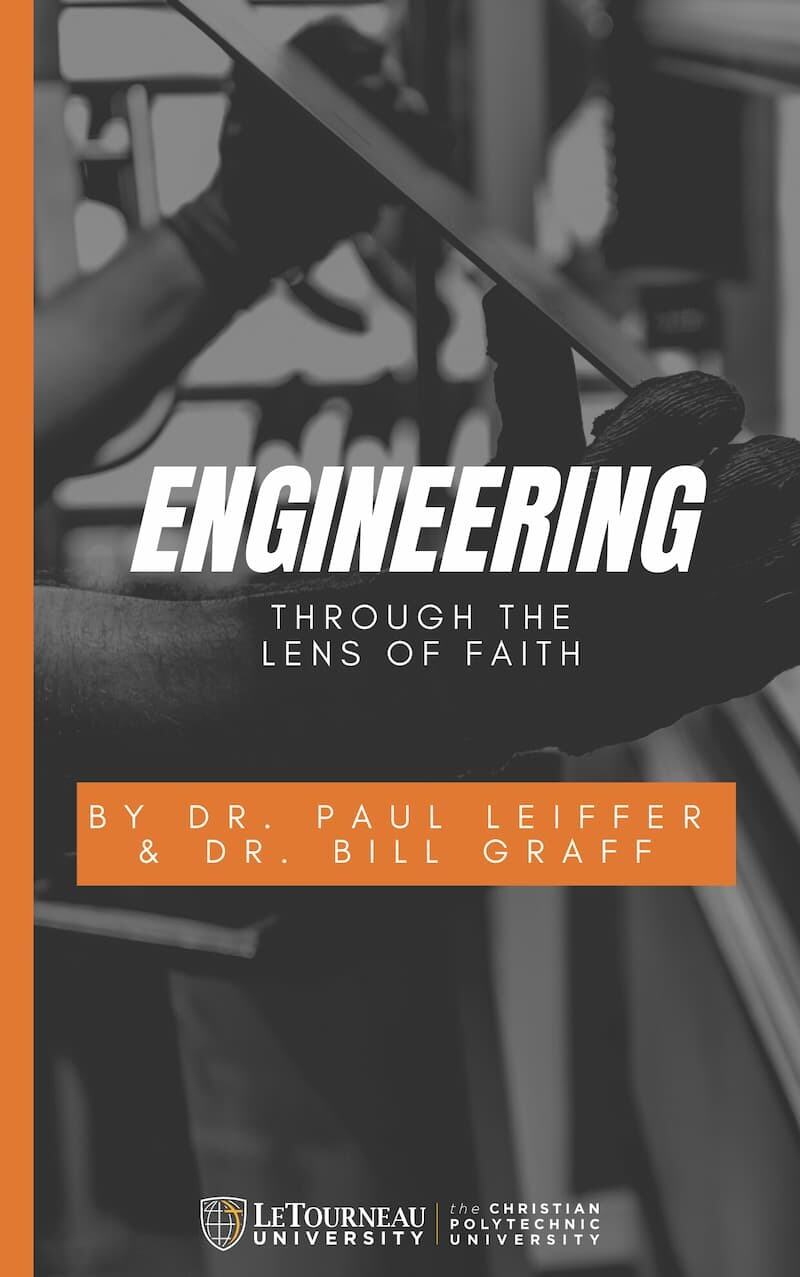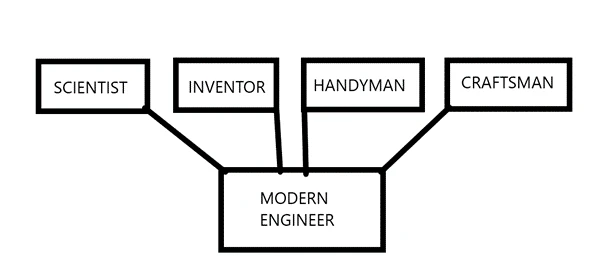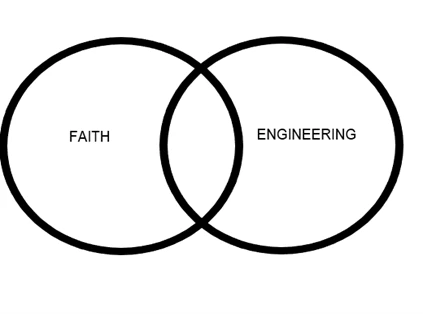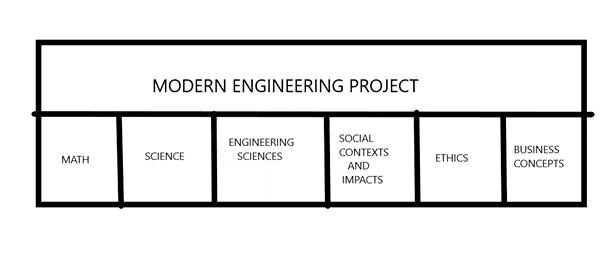 Introduction
Introduction
If we were to poll people about what an engineer is or what kind of work engineers do, we typically get these kinds of responses:
“Engineers are people who do engineering work.” (That helps a lot.)
“Engineers work in little cubicles and crunch numbers on computers.”
“Engineers used to recognizable by white shirts, white socks, pen protectors, and slide rules.”
“Engineers design bridges and machines.” (Some do.)
In this chapter we’ll take a brief look at the nature and history of engineering, some of its achievements, and recent thoughts on the philosophy of engineering.
What is Engineering?
As a student in an Engineering program I (Paul) was taught this definition of engineering: “Engineering is the practical application of science and mathematics to the benefit of mankind.”
Note the key concepts embedded in this definition.
- Engineering is practical. There will be practical results from engineering efforts.
- Engineering is application oriented. Unlike applied science which may be looking for an application, real engineering arises from a need or a problem or an opportunity.
- Engineering is based on the principles of mathematics and science. The math used may be simple algebra or complex partial differential equations, but math and science are foundational to engineering work.
- Engineering results in something of benefit to mankind.
Let’s look at a few other definitions:
- “[Engineering is} (t)he profession in which knowledge of the mathematical and natural sciences, gained by study, experience, and practice, is applied with judgment to develop ways to use, economically, the materials and forces of nature for the benefit of mankind.” [1]
- Engineering is defined as the “application of scientific and mathematical principles to practical ends such as the design, manufacture, and operation of efficient and economical structures, machines, processes, and systems”. The term engineering is derived from “Middle English enginour, from Old French engigneor, from Medieval Latin ingeniator, contriver, from ingeniare, to contrive, from Latin ingenium, ability.” [2]
- “Engineering,” says Goldberg, “is the social practice of conceiving, designing, implementing, and sustaining complex artifacts, processes, or systems appropriate to some meaningful need.” [3]
- Engineering is “the transformation of the natural world, using scientific principles and mathematics, in order to achieve some desired, practical end.” [4]
- Jordan proposes this definition, inspired by Billy Koen’s Definition of the Engineering Method [5] “(Engineering is) the application of science and human experience to solve problems faced by people. This is often done in poorly understood or uncertain situations using the available resources.” [6]
- “Today an engineer is described as someone who has acquired and is applying their scientific and technical knowledge to designing, analyzing and building useful, helpful and functional works. This would involve structures, machines and apparatus, manufacturing processes as well as forecasting their behavior in particular environmental conditions. This is all accomplished with functionality, operational economics and safety to life and property forefront in mind.” [7]
- Engineers are those whom the engineering profession recognizes as members (for example, for purposes of membership in engineering societies – “at the professional level”). That way of identifying engineers would ask us to ask what, if anything, engineers – at a certain moment – contribute that others do not – that is, what significance their special standards of conduct have for others. The answer may well interest many in the history, sociology, and philosophy – technology because it provides a way to study what effect, if any, differences in profession have on the technology members of professions make or use. [8]
- “Engineers are problem solvers. They are innovators and inventors, designers and creators. They are team players from a small group setting to a global perspective…We take problems or ideas, break them down, develop a solution and a path forward, and then turn it into reality.” [9]
Engineering Differs from Science
To the public at large, suggests Henry Petroski, the image of the inventor of modern technology is someone in a laboratory somewhere wearing a white lab coat, in fact, a scientist rather than an engineer. [10] Engineering is dependent upon science, but engineering is not science. Engineering is not even applied science. While science strives to understand how things work in the natural world, engineering is about making things work. Engineering begins with a need to be addressed or a specific technical problem to be solved.
Engineering as practiced is the creative application of scientific principles to a problem with given specifications. In the case of the steam engine and the airplane, the earliest designs were completed before the science behind them was correctly understood. [11] The world needs both scientists and engineers, often working together to solve the large problems of society.
- The core activity of science is discovery.
- The core activity of technology is invention.
- The core activity of engineering is making. [12]
Theodore Von Karman, an early aerospace engineer wrote that “Scientists discover the world that exists; engineers create the world that never was.” [13]
Unlike the painter and composer engineers almost never get to sign their work. Often a significant discovery will be associated with the name of a given scientist. The engineer will initial and stamp drawings and submit design reports, but the public is usually unaware of the identity of the designer of the bridge or the developer of the amplifier.
Up to the mid-20th Century, engineering was usually a response to a physical need. For example, steam engines were developed by Savery, Newcomen, Watt, Trevithick and others, to pump water from mineshafts. [14] Abraham Darby’s efforts to refine iron production were motivated by the need for cheaper cooking pots; and the chlorination of water by John Snow was in response to the 1854 Cholera epidemic. [15]
Engineers may not typically be skilled at fixing cars or appliances, but engineering is concerned with problem solving, or fixing problems. We often portray the idea that we want to fix everything, hence the concept of tinkering with basic social structures, or “social engineering.” We can, in fact, tinker with and alter much of nature, but is it always a good thing?
Today the press and the government have made a strong emphasis on STEM (science-technology-engineering-math) education, tying it to the future of our society. Young people are primarily interested in the aspects that (1) engineering is a field that helps people and (2) engineering is field with significant hands-on activity.
Students chose engineering careers because they have a knack for technical work, they enjoy the thrill of solving new problems, they want to make a difference in the world, and they are aware that engineering is a stable career in high demand. [16]
Engineering is also a very versatile background. Students who earned an engineering degree have gone to careers in law, medicine, business, education, and ministry.
Brief History of Engineering
Early cultures mastered the making of tools and weapons, as seen in many artifacts found in archaeological digs. When we think of engineering projects throughout history, several were enormous in both scope and personnel needed: the pyramids of Egypt, Roman aqueducts, and ancient cities, such as Ephesus in Turkey.
Early engineering provided the basis for construction, metalworking, water transport, military and agricultural tools.
Although the term “engineer” was not introduced for over a thousand years, individuals with great talent were present in Egypt, Greece, and Rome, designing and overseeing construction of the pyramids, bridges, roads, stadiums, and aqueducts. Pulleys and gears were employed in construction and transportation.
The Industrial Revolution saw human power replaced with machine power, primarily from steam engines.
An “engineer” was originally a designer/builder of military machines. Eventually these engineers became “military engineers” while developers of bridges, roads, and buildings for the public became known as “civil engineers.”
“Civil engineering is the oldest of the engineering disciplines. It began as a distinction from military engineering to cover anything designed for civilian use. Since then it has gone on to become an umbrella term for anything related to infrastructure (roads, bridges), structures (factories, skyscrapers), and environmental concerns (water and sewage treatment).” [18]
Modern engineering (since the 19th century) has used math and science as foundations and now has a well-developed design process. Electrical engineering, Biomedical engineering, and Industrial engineering date to the 20th century.
Engineering in 1915 looked a lot like what we call Engineering Technology today, with a heavy emphasis on basic math and hands-on techniques. By the 1960’s, particularly as a result of the space race, the educational emphasis was placed on higher math (through differential equations) and engineering science (statics, dynamics, circuits, thermodynamics…) with minimum design. Accreditation efforts in the 1980’s made engineering design a major part of the curriculum.
The twentieth century alone saw the development of affordable automobiles, airplanes, radio, television, radar, copy machines, transistors, computers, cell phones, robots, and the Internet.
Engineering, it seems, goes through three phases in a culture, or functions primarily in one of these phases depending on the level of development of the culture:
- Basic provision, maintenance of life (most basic level) –food, clothing, shelter, safety
- Reparative/restorative –clean water, sanitation, better housing, disaster recovery
- Cultural and technological advances (most developed level, once basic needs are met, and equilibrium is restored)- transportation, telephones, and computers.
Roots of Engineering
The modern engineer has four career ancestors whose skills merge in the current professional:
- The craftsman, who implemented high quality finished products, especially from metals, without developing new devices
- The handyman, who was able to fix or assemble things from available parts
- The inventor, like Thomas Edison, who produced working devices and products without fully understanding the science behind them, and
- The scientist, who studied and systematized the laws of nature but typically did not apply them to practical ends

Ideally, a modern engineer combines the skills of each of these: an understanding of the scientific principles behind working systems, a creative mindset to envision new solutions, and an ability to fabricate or assemble new devices.
Following William Rosen’s propositions in The Most Powerful Idea in the World [19]), Craig Gay writes that the “Machine Age,” or the age of modern engineering, really began with the invention and application of the steam engine. At this point in history “the wall between scientific theory and practice that had stood for centuries was finally broken down.” [20]:
- Dozens of scientific principles were practically applied.
- In addition to inventive ingenuity, steps of analysis and design were used.
- Equations and calculations were absolutely necessary.
Unlike the windmill or waterwheel which use the forces of nature in ordinary ways, the steam engine used forces of nature in a new way, harnessing the power of water heated to steam. [21]

Engineering Achievements
As we look through history most of what we would consider to be major engineering advances would be large-scale systems and projects, rather than individual inventions:
A team of engineers was responsible for:
- Design of current automobiles and their manufacturing
- Development and functioning of the nation’s electrical grid
- Design of the Space Shuttle, particularly the Command Module and Lunar Explorer
- Layout and construction plans for the nation’s highways
- Design of all levels of computers and smart phones
- Development of machinery for processing and packaging foods
- Design of the cardiac pacemaker, prosthetic limbs, and the MRI machinery
- Purifying and pumping water to homes
- Design and manufacture of household appliances
- Alternate energy sources- photovoltaics and wind turbines
- Equipment for oil exploration, drilling, and pumping
- Equipment for processing hydrocarbons into plastics
Value of Engineering
Whenever we entertain a romantic idea that it would have been wonderful to have lived in a previous century, we need to recall how much of what we take for granted that didn’t exist a century or two earlier: [22]
- Purified drinking water
- Sewage processing
- Refrigeration to prevent food spoilage
- Safe home heating
- Kitchen appliances
- Workplace safety
- Safe, efficient travel
Now you might think you would like to be Louis XIV, or Louis XVI, you might think you would like to have been Henry VIII and live in a palace. But if that were the case for you, even at best you would just be doing everything you could to make sure you ate, your family ate and all your subjects had enough food so they didn't starve to death and that your army was strong enough so that it could at least fight if another army engaged it. You might think you would like to have been in an eighteenth or nineteenth century king, but you would have had to do without electricity and all its powers, lights, telephones, radio, television, refrigerators, air conditioners, fans, VCRs, Xrays, MRIs, computers, the Internet, …and all other industrial automation. [23]
Leaders recognize that engineering is one of our most essential fields, for multiple reasons:
- Most of the products we use daily have been engineered and manufactured.
- Innovation and product development are keys to a growing economy.
- Many problems around the world have engineering solutions, including clean water, communication, lost limbs, and detection of weapons.
- International development relies heavily on technology: roads, water, safe shelter, small-scale manufacturing.
- Government leaders recognize the value of a STEM education.
- Engineers are hired even during a sluggish economy.
- A background in engineering can get someone into nearly any country on earth.
Engineering Disciplines and Occupations
Engineering activity is responsible for the existence of most of the physical items we use each day as well as our economic progress. Engineering intersects with seven of the major sectors of our economy:
- Energy
- Utilities
- Industrial (manufacturing)
- Consumer products
- Technology
- Health Care
- Materials
Traditional disciplines of Engineering include:
- Chemical engineers- develop chemical processes and plants
- Civil engineers- develop structures, highways, bridges, dams
- Electrical engineers- develop circuits, electronic components, controllers, power systems
- Industrial engineers-
- Mechanical engineers- develop systems using machinery, heat, fluids, and engines
Recent additional areas include
- Aerospace Engineering
- Biomedical engineers- develop devices to assist the human body
- Computer engineers- develop computer hardware and interfaces
- Materials Engineering
- Materials Joining Engineering
- Systems Engineering
Engineers find work in a number of large industry groups:
- Aerospace/Aviation
- Chemical
- Communications
- Computers
- Construction
- Consumer Goods
- Defense
- Electronics
- Pharmaceuticals
- Utilities
For many, their job titles may reflect the nature of their work:
- Consulting Engineer
- Design Engineer
- Engineering management
- Engineering research
- Engineering sales
- Product development
- Production engineering
- Manufacturing Engineer
- Project Engineer/Project manager
- Systems Engineer
- Test Engineer
Modern Engineering
Twenty-First Century engineering requires considerably more content than the engineering that was practiced a hundred years ago. In addition to mastering math, science, appropriate liberal arts and “engineering science,” graduates must be fluent in communication, skilled in basic design, capable of reasoning ethically, and able to work in teams. They need to understand the social-cultural context of their design, the economics of producing it, and the impacts of using it.

An NSF report titled “The Engineer of 2020” called for the next generation of engineers to be even more flexible, global, and creative. [24] Now that 2020 has come and gone we need to examine how well we’ve done.
Philosophy of Engineering
An interesting field of study has developed in the past few years known as Philosophy of Engineering (POE). Carl Mitcham, Daniel Goldberg, Ibo Van de Poel, Taft Broome, and Louis Buciarelli have approached engineering from a philosophical framework. [25], [26], [27], [28]
Taft Broome, for example, looks at engineering (as a “learned discipline”) in three aspects: [29]
- Foundations of engineering –mathematics, science, and humanities, based in Greek philosophy and literature –engineering as a popular learned discipline
- Theoretical dimensions of engineering –engineering as a priestly discipline
- Practical dimensions of engineering –engineering as a regal discipline
Learned content includes knowledge, values, praxis, practice, and skills.
A philosophy of engineering asks such questions as:
- What is the nature of engineering?
- Who is an engineer?
- What does an engineer do?
- What is the nature of engineering artifacts?
- What are the foundations of engineering ethics?
- How do we handle the products of engineering work (technology)?
Many of these topics will be touched in succeeding chapters, primarily from a theological perspective. It is our contention that many philosophical issues have basically satisfying theological answers, if we accept the reality of the God of the Bible. In addition, we should consider:
- How does God view our work?
- Where does our work fit within the larger plan of God?
- How does ethics relate to faith?
Conclusion
Former US President Herbert Hoover (educated as a mining engineer) wrote, “[Engineering] is a great profession. There is the fascination of watching a figment of the imagination emerge through the aid of science to a plan on paper. Then it moves to realization in stone or metal or energy. Then it brings jobs and homes… Then it elevates the standards of living and adds to the comforts of life. That is the engineer’s high privilege.” [30]
- Engineering is a human activity
- Engineering is a creative activity
- Engineering is a science-inspired activity
- Engineering is a social activity
In general, Engineering is a vocation ordained by God. Engineers make use of the physical laws and materials created by God. Engineers use their God-given aptitudes to develop solutions to bless others.
Rethinking our definition:
Engineering is the activity of developing technical solutions to meet the needs of humans (made in the image of God) using mathematics, science, and available resources to the glory of God.
References
- Accreditation Board For Engineering and Technology (ABET), 1998.
- American Heritage Dictionary
- Goldberg, D. E. (2009b). “What engineers don’t learn and why they don’t learn it: A cold war curriculum in a creative world & how to fix it “[ppt file]. http://tinyurl.com/auojct
- Luegenbiehl, H., “Ethical Principles for Engineers in a Global Environment,” in Van De Pol and Goldberg, Philosophy and Engineering, Springer, 2010, p. 153.
- Koen, B.K., Discussion of the Method, Oxford University Press, 2003.
- W. Jordan, Elmore, and S. Napper, “A Biblical Perspective on Engineering Ethics,” Proceedings Christian Engineering Conference 2002.
- “A Brief History of Engineering,” http://www.streetdirectory.com/travel_guide/192894/careers_and_job_hunting/a_brief_history_of_engineering.html
- Davis, M., Thinking like an Engineer: Studies in the Ethics of a Profession. New York: Oxford UP, 1998, p. 177.
- Texas Eastman staff, “Why Are We Here?” Longview, TX Engineer’s Week, 2016.
- Petroski, H., “Engineering is Not Science,” IEEE Spectrum, Nov.2010. https://spectrum.ieee.org/at-work/tech-careers/engineering-is-not-science
- Ibid.
- Van der Pol I., and Goldberg, D.E., Philosophy and Engineering, Springer, 2010, p.5.
- Von Karman, T., quoted, https://www.goodreads.com/quotes/140931-scientists-discover-the-world-that-exists-engineers-create-the-world
- Marsden, B., Watt’s Perfect Steam Engine and the Age of Invention, Cambridge University Press, 2002.
- Clifford, M. J., “Engineering in the 21st Century - A Trivial Pursuit?” (2007) http://exerceojournal.org
- Texas Eastman staff, op. cit.
- “A Brief History of Engineering,” http://www.bovayengineers.com/a-brief-history-of-engineering
- “Civil Engineering,” ASEE, ABET.
- Rosen, W., The Most Powerful Idea in the World, New York, Random House, 2010.
- Gay, C., Modern Technology and the Human Future, IVP, 2018, p. 28-29.
- Ibid.
- MacArthur, J., “The Curse on the Man-2,” Grace to You Sermon archive, http://www.gty.org/resources/sermons/90-246/the-curse-on-the-man-part-2
- Ibid.
- National Academy of Engineering. 2004. The Engineer of 2020: Visions of Engineering in the New Century. Washington, DC: The National Academies Press. https://doi.org/10.17226/10999.
- Van de Pol and Goldberg, op.cit.
- Mitcham, C., Thinking Through Technology, Univ. Chicago Press, 1994.
- Broome, T.H. 2002. Philosophy of Engineering. Keynote Address: Ethics Across the Curriculum, Annual Meeting. Clemson University, Columbia, SC—October 26.
- Buciarelli, L., Designing Engineers, Cambridge, 1994.
- Broome, T., “The Nature of Engineering,” in Engineering Ethics course, MIT Open Courseware, 2006. https://ocw.mit.edu/courses/engineering-systems-division/esd-932-engineering-ethics-spring-2006/readings/broome_preface.pdf
- Hoover, H., “Engineering,” http://artjohnson.umd.edu/courses/bioe332/bioe332-hoover.pdf